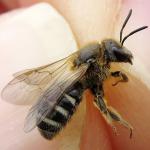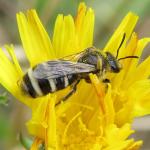Restricted to southern England and south Wales, with a few occurrences in the Welsh borders and an old specimen is known from north Wales (Criccieth). Known from the Channel Islands (Sark, I C Beavis, pers. comm.). Abroad, an Holarctic species, probably introduced to North America. Widely distributed in the temperate and warm zones of the Palaearctic and north Oriental regions.
This species is not regarded as being scarce or threatened.
The species shows a preference for woodland rides and sometimes is coastal. Not frequent on calcareous soils.
Univoltine. The females fly from early April to October, males from June to September.
A solitary mining bee nesting in areas exposed to the sun. The main burrow is almost vertical down to a depth of some 20 cm, where it is widened into a blind ending. Cells are constructed, each at the end of a short lateral burrow, starting at a depth of 10 cm below the ground level. Cells are pyriform with polished walls, and are sealed after being provisioned and an egg laid. The pollen provisioned is frequently yellow. After copulation, the young females hibernate in the maternal nest, lengthening the burrow to 40-50 cm and constructing individual hibernaculae. It has been suggested that the foundress female may live up to two years (Pesenko et al. 2000).
The bees visit a range of botanical families.
The bee Sphecodes scabricollis is thought to be a cleptoparasite of L. zonulum, the two species having been dug out of the soil together (C R Vardy; specimens in the Natural History Museum, London). The species also have rather similar ranges in the UK, although S. scabricollis is much more scarce.
2006





